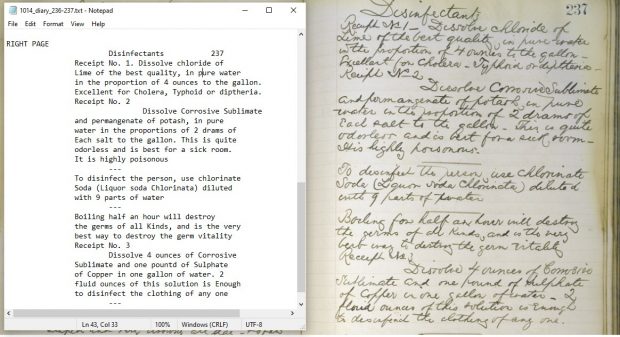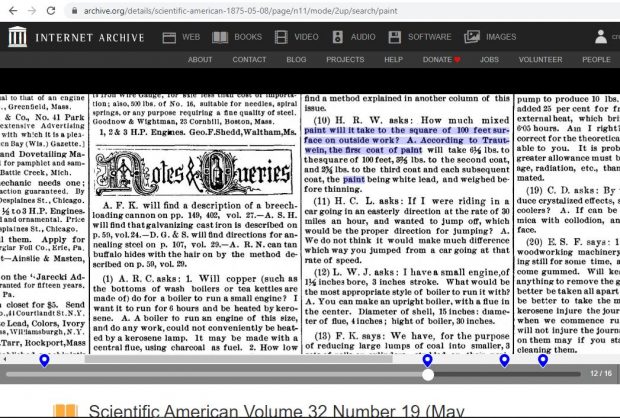When our Province announced a limited shutdown of public spaces, the University had to pivot quickly.
How can we work from home when most of our work is done using specialized equipment?
Our department had a meeting on Monday March 16th and we agreed that while we couldn’t take the equipment to our homes, we could do transcription work, which is typically assigned to work study students, to get us through. We identified three projects right away that could be done and I happily claimed a book from the Frank and Cecelia Sylvester Fonds (collection) in the UVic Archives that we had digitized way back in 2008 as part of the Victoria’s Early History collection. We found some portable drives, transferred images over while we wrapped up or put on pause digitization projects in progress, and were working from home by Wednesday March 18th; the Library had shut down completely by Friday the 20th.
Within our department, we referred to the book I chose as “Frank Sylvester’s Commonplace Book” but it has other names and descriptions in Finding Aids and catalogs. It is a personal keepsake book — kind of an old-time bullet journal — part diary, part scrapbook, part record book, kept by Frank Sylvester, one of the first Jewish settlers to the city. It spans a couple of decades from the late 1800s to the early 1900s, though it’s not fully chronological and in some cases Sylvester pasted clippings over older writing and tore or cut out pages, sometimes in clumps.
In September, we were approved for some very part-time return to on campus work — for our department this works out to 7 hours each per week on campus, the remainder still working from home. I had estimated 14 weeks of work to do the transcribing for the Commonplace Book but it was a little slower (owing in part to actually taking vacation time, but also the complexity of some pages) and I finally finished the transcription in late October with proofreading taking me until December!
So what’s in this book?

Sylvester was very involved in the City in a lot of little ways. He worked for an auctioneer for a while, was involved with the Alert Bay Salmon Cannery, was a member of the Naturalist Society, took part in some whaling trips, was an avid reader (with an early library card!) who tracked his reading, GoodReads style, and was very curious about science — writing down lots of receipts (recipes) for various glues and cements, and new advances in engineering (especially steamships), astronomy, and mining.
He tracked some significant family events (weddings, funerals, performances), and made note of shipwrecks around the Island. Several pages are devoted to a whaling trip he joined that lasted months and netted nothing in the end — so annoyed was the crew that they sold the ship almost as soon as they returned to Victoria harbour.
There are also some financial records that reveal the kind of businessman Sylvester was, and long lists of equivalencies in measures, compass directions and other wayfinding tips, cures for various ailments, and more.
The book itself is physically large and the digital object contains nearly 250 images. To complete my proof reading, I requested the book from Special Collections and Archives and before returning it I posed with it, to give you some context of it both closed and open to an average page of entries.
What does transcription look like?
On my desktop, I would open an image of a double page spread and a text document with a matching filename, then I would just type what I read, as written on the page into the document. I did my best to preserve formatting, though that may or may not carry over in the final format online. In an average day, I completed two to three double-page spreads.

For clippings, this is relatively easy as the print is clear, though dense. For handwritten entries (the bulk of the content), I had to learn to read Sylvester’s writing, including any abbreviations and symbols he used, which needed to be expanded. For example an ampersand in the text would be transcribed as “& [and]” for clarification. He also frequently ran together words, missed words, or misspelled them. It often meant searching on Google for the correct spelling of important words. Most misspellings are left in place — for example Sylvester frequently misspelled different as “differant” — but medical terms, chemicals, and place names are typically corrected in square brackets. One place frequently mentioned is San Francisco, as there were many ties between the cities due to shipping routes, which Sylvester commonly wrote as “Frisco” so this is seen in the transcript as “Frisco [San Francisco].” Note that the typo in the above transcription, “pountd” was among the many I corrected as I proofread the files.
Essentially, the work is straightforward, just typing what I see but sometimes it’s not just the spelling that’s unclear. Since the entries are all over 100 years old, there are many products that are not commonly known to most modern readers – Gutta Percha (which today is mostly used for dental work!) or Tripoli powder/rottenstone (an abrasive still used for metal polishing), as examples. One of the more challenging lists to double check was a long list of “famous operas” which were listed by the author/composer. His memory of the titles was not always that clear, so there are plenty of corrections in square brackets.
Many of his household tips and DIY recipes were copied from magazines — mostly Scientific American. And to my delight, issues of Scientific American from 1845-1909 are available on the Internet Archive so I frequently double checked when I couldn’t read Sylvester’s writing, or when he only gave a date or issue but no title — so you’ll often see [Scientific American] to show where I did double check.


What was it like to work from home?

I am incredibly grateful that my workplace was able to pivot so quickly and that we were offered whatever we needed to make working from home not only possible but also comfortable. I already had a home workstation with a reliable laptop at a good height, and a decent office chair. I just needed the portable drive and to remember to take breaks to stretch and to refocus my eyes.
As I worked, I also shared posts about what I was doing on my personal social media accounts — something I’ve always done, but which somehow seemed more important during the pandemic — and the combination of history, local interest, and normality made many of the posts quite popular. Some of the photos from those posts are included in this post.
Our manager arranged for regular unit meetings over Zoom — weekly initially then every other week as we rolled into summer and all got into regular routines. Our head librarian sent out an almost daily update (and continues to this day) numbering them, whether they contained important details, or words of encouragement and gratitude. Open communications were the lifesaver throughout this transition to decentralized work.
I was still able to attend work and union related conferences — American Library Association in June, Oxford Library 700 Conference in September, BC Federation of Labour in November — and take vacation, and for the most part enjoy a “regular” year of work even though I was constantly reminded it was not normal. I will admit to enjoying the zero-minute commute and constant access to fresh coffee, though.
What’s next?
We’re continuing our current blend of 7 hours on site and the remainder at home for at least the next term, into the spring of 2021. In November, I started transcribing the text from the first of the Victoria Police Department “mugshot books” — ledgers with photos of people who had been arrested (and often convicted) for various crimes throughout the 1890s and early 1900s. These were digitized a few years ago but weren’t searchable. Transcriptions will make searching for people easier; for many of these folks, this may have been the only time they were photographed.
The Sylvester transcriptions have been passed along to the Cataloguing and Metadata folks who’ve added it to their work queue. I’ll update this post once they’ve been uploaded to the new servers.
